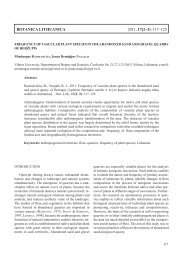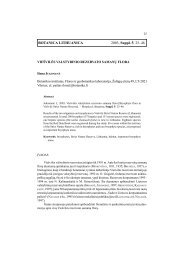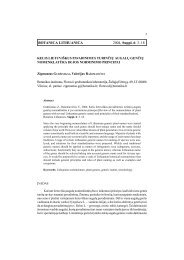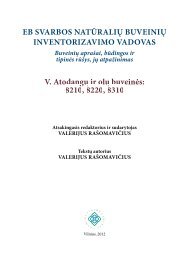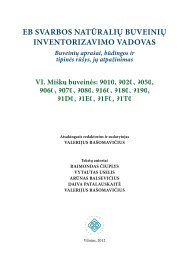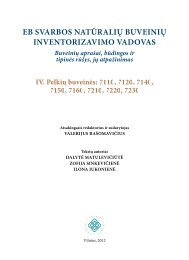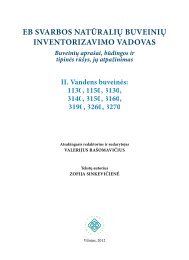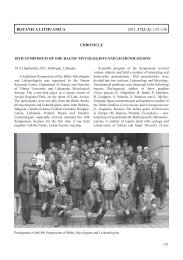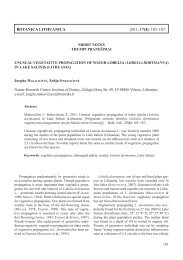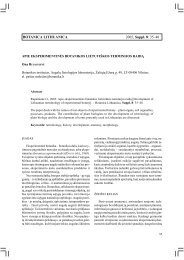FUNGI AND LICHENS IN THE BALTICS AND BEYOND XVIII ...
FUNGI AND LICHENS IN THE BALTICS AND BEYOND XVIII ...
FUNGI AND LICHENS IN THE BALTICS AND BEYOND XVIII ...
Create successful ePaper yourself
Turn your PDF publications into a flip-book with our unique Google optimized e-Paper software.
Nordic Lichen Flora vol. 4 – Parmeliaceae contains 152 species divided to 41 genera, treated<br />
as separate chapters by 13 researchers specializing in different groups of the Parmeliaceae.<br />
This new flora is presented including novelties in taxonomy and changes in distribution of<br />
some of the Nordic species.<br />
<strong>LICHENS</strong> OF GOMEL REGION STUDY: HISTORY OF <strong>THE</strong> SUBJECT<br />
A. H. TSURYKAU, V. M. KHRAMCHANKOVA<br />
F. Skoryna Gomel State University, Sovetskaya Str. 104, Gomel, Belarus<br />
E-mails: tsurikov@front.ru, hramchenkova@gsu.by<br />
The lichen flora of the Republic of Belarus is studied very unevenly. The main data<br />
concerns “Byelovezhskaya Pushcha” National park and the northern part of the Republic.<br />
Lichens of the southern part of Belarus are understudied. A more integrated analysis of the<br />
species structure of lichen flora of Gomel region seems important.<br />
The initial information about Gomel Polesye lichen flora relates to the beginning of<br />
the XX century (Savich, 1909). By 1914 V. P. Savich and L. I. Lubitskaya had described 137<br />
lichen species mainly for Mozyr and Rechitsa vicinities. The next step in lichen investigation<br />
was the article by D. K. Ges published in 1960 in which 67 species of lichens were reported<br />
including 15 new to Gomel region. The Handbooks of lichens of Belarus published in 1965<br />
and 1973 by N. V. Gorbach were a huge generalization of the long-term data. The total<br />
number of lichen species for Belarus was 494, including 121 species for Gomel region, 21 of<br />
which were new to it.<br />
The lichen flora of “Pripyatsky” National park was studied in 1982–1983 by the<br />
researchers of V. F. Kuprevich Experimental Botany Institute of the National Academy of<br />
Sciences of Belarus. In his PhD thesis, V. V. Golubkov reported 184 species and 2 subspecies<br />
for the National park and 97 for “Mozyr ravines” reserve. The thesis contained the<br />
information about 84 rare species for Gomel region including 43 species new to it. 25 years<br />
later, in 2007, V. V. Golubkov et al. reported 163 species for “Mozyr ravines” reserve. 15<br />
species were new to Gomel region. In 1994–1999 during the lichen monitoring research 45<br />
species of lichens were found in the cities of Gomel and Svetlogorsk by L. A. Kravchuk. 5<br />
new species among them were recorded.<br />
Since 2002 we have been carrying out investigations in Gomel and neighbouring<br />
districts. As a result 3 families, 3 genera, 27 species and 1 subspecies were determined for<br />
Gomel region for the first time. 3 lichen species (i.e. Arthonia fuliginosa (Schaerer) Flotow,<br />
Caloplaca flavocitrina (Nyl.) H. Olivier and Cyphelium notarisii (Tul.) Blomb. & Forssel)<br />
were found to be new to Belarus (Tsurykau, 2011; Tsurykau, Kondratyuk, 2011).<br />
So far 263 species and 1 subspecies of lichens are known for Gomel region.<br />
<strong>LICHENS</strong> ON SUBSTRATES RICH <strong>IN</strong> COPPER <strong>AND</strong> IRON<br />
S. WALL<br />
Department of Chemistry, University of Gothenburg, SE- 412 96 Gothenburg, Sweden<br />
E-mail: wall@chem.gu.se<br />
There is a number of lichens restricted to substrates rich in iron and/or copper. These<br />
can mainly be found on waste heaps around mines. Especially when these waste heaps have<br />
been exposed for around 50 years or more the lichen flora is usually very rich. Investigations



